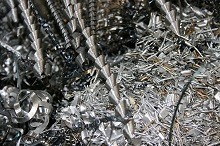later post | index | earlier post
What are different metals used for?
Monday, 5 October 2015

If you’re new to the world of metal recycling, the amount of different metals and their uses might be a bit surprising: it’s very easy to forget just how much goes into our day-to-day lives behind the scenes!
We thought it would be interesting to take a look at the uses of different metals in the day-to-day. As well as being informative, it will also give you some idea as to which metals you have in your possession that could be worth trading in!
Aluminium
Aluminium has a ton of great recycling potential, and will often be recycled to become exactly the same thing it was when originally manufactured! It’s flexible, strong and light-weight. Some of the main uses for aluminium include:
- Building and construction, where it’s used for window frames, building structures and roofs, among other things.
- Transportation, where it’s used to help construct aeroplanes, trains, boats and cars, as well as smaller vehicles such as bicycles and motorbikes.
- Packaging, where it’s used as the main material for cans and foil.
- Electricity, where it’s used as the main material in the high-voltage lines.
Copper
As the best electrical conductor except for silver, copper is very valuable: indeed, it’s the most frequently sold valuable material in the industry. Common uses of copper include:
- Electrical applications, where it’s frequently used for wires, circuits, switches and electromagnets.
- Piping and plumbing: refrigeration, air conditioning and water supply systems.
- Roofing and insulation.
- Household items such as cookware, doorknobs and cutlery.
Lead
Typically, the majority of recycled lead comes from batteries, but there are still a number of different uses for this metal:
- Car batteries, where it’s still used extensively in the electrode plates.
- Radiation protection, where it’s used to offer protection against x-rays.
Zinc
As well as being present in the day-to-day in the form of coins, zinc is also used for other purposes, such as:
- Galvanisation, where it’s commonly used as a coating to help protect iron and steel from corroding (galvanisation is simply the name for the process).
- Batteries, where zinc is used as an anode component material.
- Brass, which is created by alloying zinc and copper.
Tin
Tin is one of the most expensive non-ferrous metals, which means that recycling it is very important! The uses of tin are quite varied, and include:
- Cans, which made use of a thin layer of tin covering a steel sheet – resulting in tinplate, the raw material used to create cans.
- Cars, where tin is used to add resistance to the motor block, piston rings and clutch plates.
- Springs, which are increased in toughness through the addition of tin.
- Glass, with tin oxide coatings added to the glass surfaces to help make them more resistant.
later post | index | earlier post
Recent posts
- What is WEEE waste?
- Can iron be recycled in the UK?
- What has the most copper in it to scrap?
- How to better understand scrap metal pricing
- Is there a link between copper and brass prices?
- How to make money from cable scrap
- How many different types of copper are there?
- What can I sell to a scrap metal yard?
- Preparing for the collection of scrap metal
- How scrap metal prices have changed in the past decade
- The continued growth of scrap car recycling in the UK
- How To Dispose of Aerosol Cans in the UK
- What to do with radioactive scrap metal
- 5 common metals that can be recycled
- Where to sell scrap metal